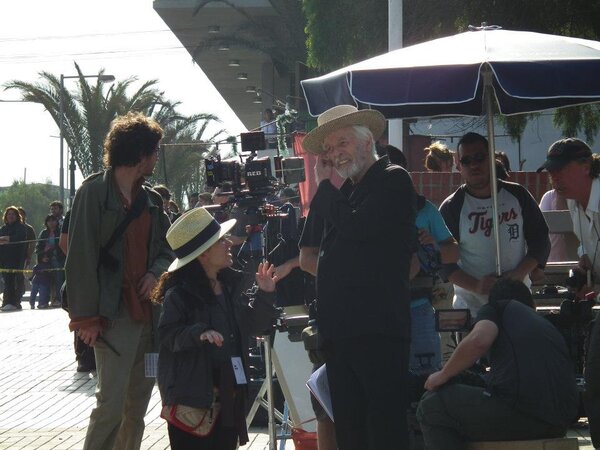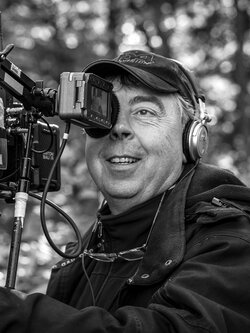Director of photography Jean-Marie Dreujou, AFC, discusses his work on “The Dance of Reality”, by Alejandro Jodorowsky

How did you come to work together on this project ?
Jean-Marie Dreujou : Producer Michel Seydoux introduced me to Alejandro Jodorowski. We got along very well when we first met, and I really liked the screenplay of his project.
Were you already familiar with Jodorowski’s universe ?
J-MD : During my small-town high school years, I sometimes worked as a projectionist in the little independent cinema nearby. That is when I discovered films like El Topo or The Holy Mountain. Both of these films had a great impact on me at the time, and they must have contributed to my calling as a cinematographer. I feel incredibly lucky to have been able to work with Alejandro.
What were his instructions ?
J-MD : He especially wanted a very bright film, with vivid, but not aggressive, colours and very little shadow. The diea was that that brightness would accompany the characters throughout the story.
We did look at a few images from the period, but that was mostly something that helped the decorator. The set was reconstructed next to a firehouse on the exact spot where the Jodorowskys’ family house once stood. It was fun to see all the memories that came up to the surface for him, during scouting even before the set had been built.
What was your greatest challenge in terms of shooting ?
J-MD : The difficulty mostly came from the very small budget we had to work with. The reconstruction of the set was a very costly production decision. But under Alejandro’s impulsion and precision, everyone played along as best they could and made do with the means we had available to us.
In any case, filming a period film with a small budget is always a challenge in itself. Digital effects helped us get rid of whatever modern element we hadn’t been able to control. Happily, Alejandro wasn’t fixated on a perfect historical recreation. What was important for him was the intensity of the story : from that point of view, I think he perfectly succeeded.
Did you discover a distinctive sort of light in Chili ?
J-MD : We filmed between June and July, which is winter for the southern hemisphere. Tocopilla, the city where the film was shot, is on the seaside and lies at the foot of the mountains and desert of Atacama. It is a place where it almost never rains ; an extremely dry climate with very pure colours and strong contrasts. For example, the opening scene on the black sand beach with the costumes, the sea, and the extremely arid earth as a backdrop. You immediately find yourself in a unique ambiance !
How does Jodorowski work on set ?
J-MD : Everything was planned out. Alejandro had a very precise vision for his film. I suggested simply that we film with two cameras so that we could bring out as much as possible during editing.
With only 45 days of shooting, we had to move quickly. And in spite of his 83 years, Alejandro surprised me with his vivacity and vitality. Sometimes, he was even astonished by how calm I was !
In terms of directing, the story is already so poetic and moving that he chose a simple, unpretentious style. When we filmed the actors moving around, one of the cameras was on a Steadicam and the second remained on the dolly. It was a very simple setup.
What equipment did you choose to use ?
J-MD : Because the Chilean production had invested in a Red Epic, we used it. I just asked them for a second camera body in order to maximize the possibilities on the cutting board.
Everything was filmed in 4K with Red 5:1 compression in order to limit the size of the data. I filmed with Angénieux Optimo zoom lenses : a 24-290mm and a 28-76mm. Because I had never had the opportunity to work with the Red before, I think that in other circumstances I would have chosen the Alexa…But things being what they were, I adapted myself to the constraints imposed by the production.
Finally, given that this was a very bright film, I am quite satisfied with its colour rendering. But I know that that isn’t always the case on certain images or sets. As for the camera itself, it’s just a block that you’ve got to accessorize a lot and that isn’t very ergonomic.
As for the light, my list was composed of an 18 kW, a 6 kW Cinepar, some Jokers and a few Kino, just the bare minimums. In Santiago, for cutting, I did a preliminary, summary colour grading using Scratch. Then, colour grader Fabrice Blin of Éclair, with whom I regularly work, finalized the film also using Scratch. Because I had filtered most of the outdoor shots with a polarizing filter, the image already had a lot of body. We mostly reworked the colour saturation and image contrast.
Is there one shot you’re particularly proud of ?
J-MD : The end of the film at the seaside is truly a magical moment. Either you do it outdoors with loads of layers of digital effects, or else inside an immense studio. In that case, we could have gotten that effect by filming exactly at the right moment. An enormous bit of meteorological luck in terms of natural light ! Like that scene, the entire film was a series of incredible miracles for Alejandro. After all, filming with someone who reads tarot cards means that you can’t escape the inexplicable !
(Interview conducted by François Reumont for the AFC and translated from French by Alex Raiffe)
 En
En Fr
Fr






